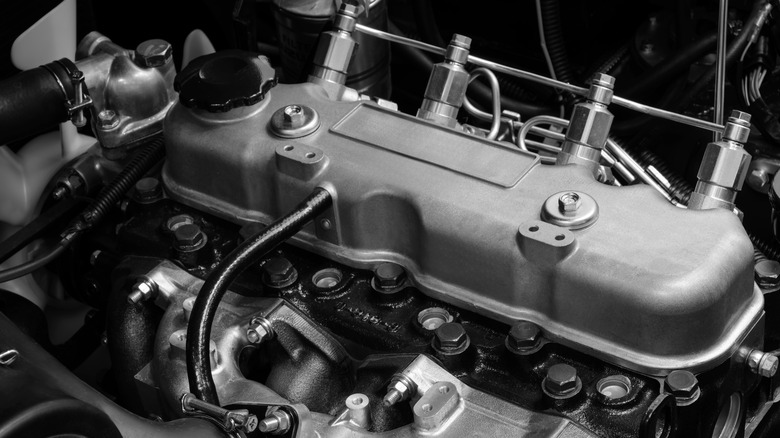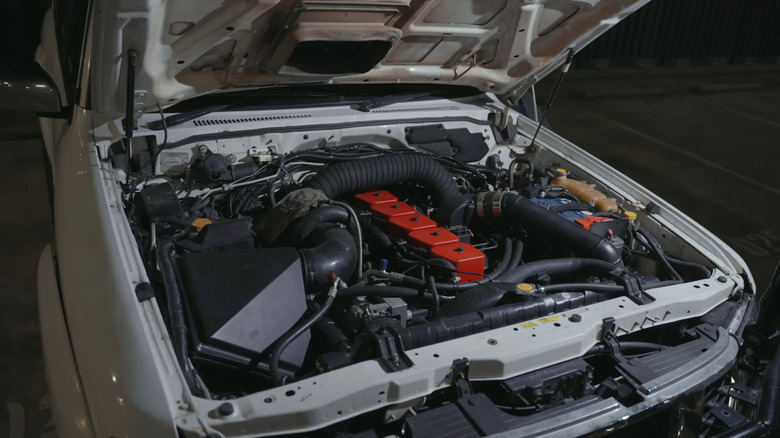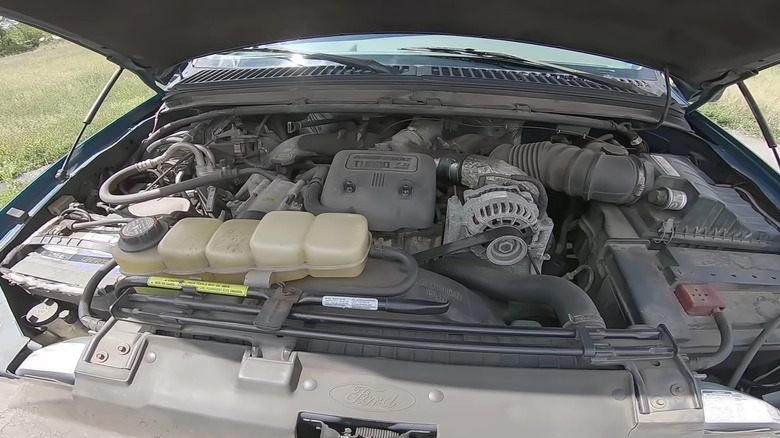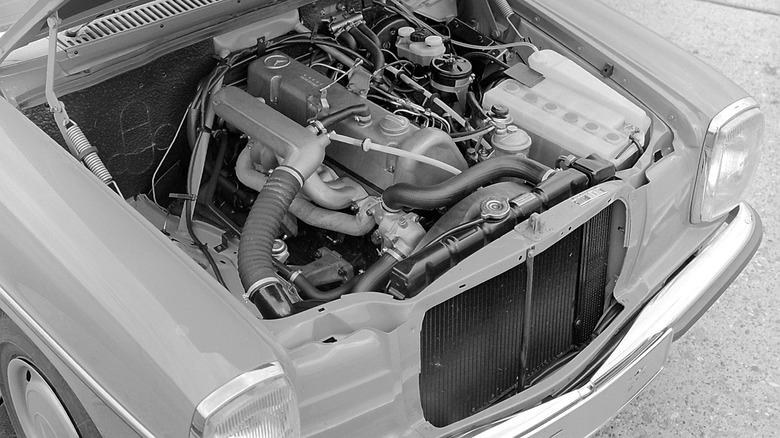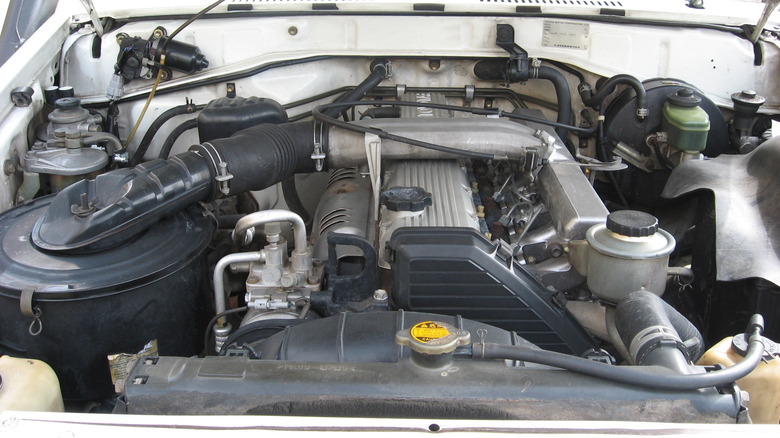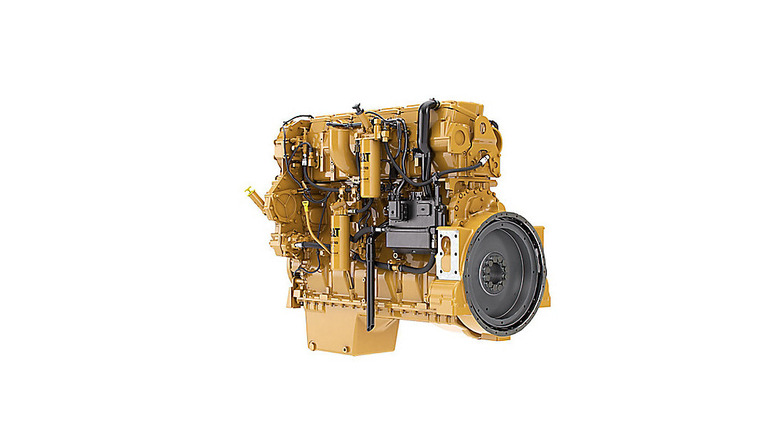5 Of The Longest-Lasting Diesel Engines Of All Time
We may receive a commission on purchases made from links.
Given the numerous advantages diesel engines offer, it's puzzling why they are almost non-existent in cars today. Yes, the Volkswagen Dieselgate scandal is partly to blame, but surely regulators could've taken steps to keep them viable. After all, they are more fuel-efficient than gas engines and produce less CO2. In other words, at least when it comes to global warming, diesel engines are friendlier to the environment. Furthermore, thanks to their higher torque output, diesel engines are better for towing and hauling. Crucially, thanks to the sturdier construction, diesel engines can also last longer than gas engines.
Don't believe that last statement? We have just the right engines to prove you wrong. Ranging from road-going trucks and cars to industrial applications, these diesels were built to stand the test of time and provide hundreds of thousands of miles of carefree motoring. Not only that, but some of these engines are real powerhouses, with torque outputs that boggle the mind. Here are five of the longest-lasting diesel engines ever made!
Cummins 5.9L/6BT inline-six (1989 to 2007)
The Cummins 6BT is easily one of the best diesel engines ever made, so much so that it saved Dodge's heavy-duty Ram trucks during the 1990s. Moreover, it gave Chrysler/Dodge a chance to compete against Ford and GM's offerings, both of which came with turbodiesel engines of their own.
Unlike Ford and GM's V8 engines, Cummins' 6BT was an inline-six. Don't confuse that with inferior, though. The 6BT had two fewer cylinders but made up for it with power and toughness. The 5.9-liter engine had direct fuel injection, which made it more advanced than its rivals. Furthermore, thanks to a Holset H1C turbocharger and air-to-air intercooler, the first 6BT produced 160 hp at 2,500 rpm and massive 400 lb-ft of torque at 1,700 rpm — both class-leading figures. More importantly, Cummins opted for a tough cast-iron block/head and a stiff forged-steel crankshaft and connecting rods.
Thanks to its stout construction, Cummins was able to evolve the 6BT significantly over the years. Power and torque rose steadily with each iteration, with the last 6BT, launched in 2004, producing 325 hp at 2,900 rpm and Earth-shattering 610 lb-ft of torque at just 1,600 rpm. These engines were also equipped with an advanced Common Rail fuel delivery system and could be tuned to over 500 hp and 1,000 lb-ft easily.
This just shows how indestructible it was. Owners could easily pass the 500,000-mile mark without significant repairs — including the turbocharger and injectors, with some getting over 700,000 miles! This would make it one of the longest-lasting truck diesel engines ever made, and an excellent tuning platform.
Navistar/Ford 7.3L Power Stroke V8 (1994 to 2003)
Ford's answer to Cummins' outstanding 6BT was the 7.3-liter Power Stroke, one of the best truck diesel engines ever built. Launched in 1994, this turbocharged V8 behemoth upped the ante with 215 hp and 425 lb-ft of torque, which rose to 425 hp and 450 lb-ft in 1996.
The Blue Oval didn't do this on its own. The 7.3-liter Power Stroke was a Navistar-designed engine. Initially, the Navistar T444E was made for International trucks, and Ford borrowed it for its Super Duty series. Regardless, it's one of the most unique diesel engines of its era. For instance, Navistar opted for hydraulic fuel injection from Caterpillar, which provided pressures as high as Common Rail (21,000 psi), but was significantly more reliable. The reason is they were utilized only once per engine cycle, compared to multiple times in other diesel injectors. Furthermore, the T444E wasn't equipped with an Exhaust Gas Recirculation (EGR) system, which is a frequent point of failure on other diesel engines.
Its construction was also very sturdy. Gray iron block and head. Forged steel crankshaft. Forged steel rods. Cast aluminum pistons. The fact that it was an unstressed unit only added to its longevity. Notably, the last version, launched in 2001, produced 275 hp and 525 lb-ft of torque — not much considering the 7.3-liter capacity. Unsurprisingly, owners report between 400,000 and 500,000 miles before significant repairs. Thanks to its excellent longevity, the T444E is still a popular engine among RV enthusiasts.
Mercedes-Benz OM617 inline-five (1974 to 1985)
Truck engines are naturally designed with longevity in mind, which makes Merc's feat with the OM617 engine even more impressive. This simple five-cylinder diesel proved to be the brand's most durable engine ever, with countless examples surpassing the 600,000-mile (1 million-kilometer mark). In fact, Gregorios Sachinidis, a taxi driver in Thessaloniki, Greece, covered 2.85 million miles (4.6 million kilometers) with his 1976 Mercedes-Benz 240D. That's the highest mileage ever recorded by a vehicle with the Mercedes emblem.
The 240D was equipped with the first version of the OM617. Launched in 1974, the naturally aspirated 3.0-liter unit produced only 79 hp, though a year later Mercedes-Benz refined the design, resulting in 88 hp. Yup, it was slow, even after it was upgraded with a turbocharger in the U.S.-bound 1977 300 SD — the first turbodiesel sedan ever made. There, it produced 110 hp and 168 lb-ft of torque, enough for a 0 to 60 mph sprint of 12.7 seconds when equipped with the four-speed automatic transmission. Other Mercedes-Benz models were later also equipped with the OM617 turbo diesel. To retain the original engine's durability, the turbo OM617 had a nitrided crankshaft with improved wear life and oil jets to cool the pistons.
Still, the OM617 also made history by breaking the 200-mph barrier in the C-111/III experimental streamliner. Equipped with a more aggressive camshaft, higher boost from its Garrett turbocharger, and an intercooler, the record-breaking OM617 produced 230 hp, enough for a top speed of 203.4 mph. Not bad for an engine primarily known for unmatched reliability!
Toyota 1HZ inline-six (1990 to Present)
It's just natural that one of the best diesel engines ever built by Toyota will also emerge on this list. A true workhorse, the 1HZ still roams isolated areas under the bonnet of the 70 Series Land Cruiser. It's a simple SOHC engine with two valves per cylinder and a mechanical fuel pump. The 1HZ's block and cylinder head are made from cast iron, and the crankshaft is forged, making it quite a sturdy unit.
There is no turbocharger onboard the 1HZ. As a result, this relatively big 4.2-liter inline-six only produces 129 hp and 210 lb-ft of torque. It is painfully slow, bringing the Land Cruiser Pickup to a top speed of only 93 mph. Yet, what the 1HZ lacks in performance, it makes up for with reliability. Easily one of the longest-lasting diesels, it has built a reputation as an engine that can reach the million-kilometer (620,000-mile) mark before a rebuild is necessary. The only thing that requires attention is the fuel pump, which often dies around the 250,000-mile mark. Many organizations, like the United Nations, Red Cross, and Médecins Sans Frontières, rely on the 1HZ to provide help in remote areas.
Crucially, it requires minimal maintenance and is easy to repair, with complete overhaul rebuild kits available on Amazon for around $700. Moreover, Toyota continues to support this engine with parts and even sells the latest Land Cruiser 78 equipped with the 1HZ in Africa. Oh, and because of its popularity, the 1HZ also enjoys good aftermarket tuning support, with turbo kits and low-compression pistons bringing its power figures in line with modern turbodiesel engines.
Caterpillar C15 (1998 to 2007)
The Caterpillar C15 inline-six turbodiesel is a common choice in any heavy-duty industry that requires an internal combustion engine. It was extensively used in semis worldwide, like the Peterbilt 389, Kenworth T904, Western Star 4964F, and International 9990i. However, it also found use in marine applications. Agricultural equipment. Construction equipment. Power generation. You name it, there is a version of the C15 that moves things around.
Of course, the main reason for its popularity is the outstanding durability. With regular maintenance, these things last for over one million miles! Naturally, the C15 is built from sturdy parts, but that's just part of the story. Its predecessor, the 3406, was built the same way and was already a long-lasting engine. Still, the C15 amped things up with a higher-volume oil pump, which cooled and lubricated internal parts better, making it even more reliable than the predecessor. That's despite the fact that the C15 also had modern features, like Common Rail direct injection and advanced electronics.
Thanks to the application of modern features, the C15 is quite a potent turbodiesel engine. A 15.2-liter inline-six unit, the C15 produces between 475 and 580 hp depending on the application, and up to a staggering 2,000 lb-ft of torque. The C15 also enjoys excellent aftermarket support, with simple ECU and other upgrades bringing even more power.
